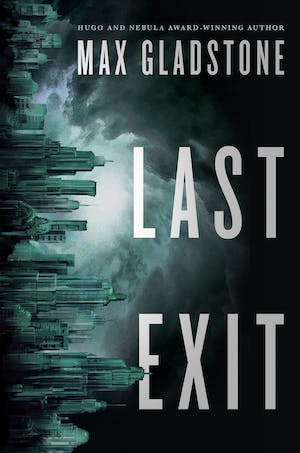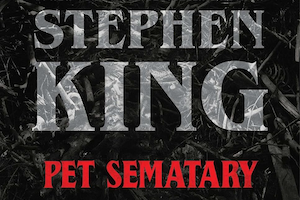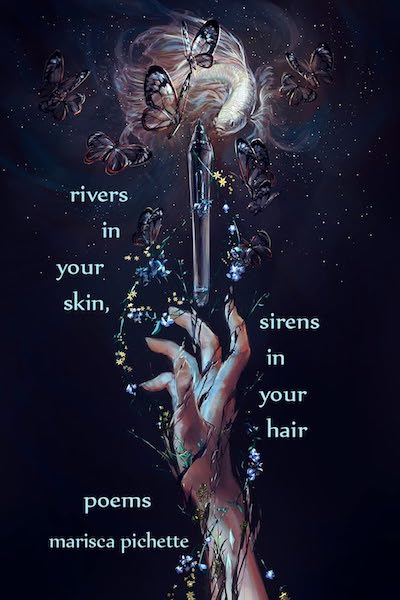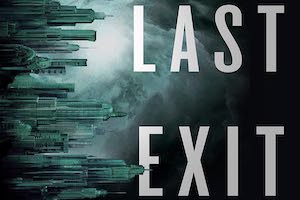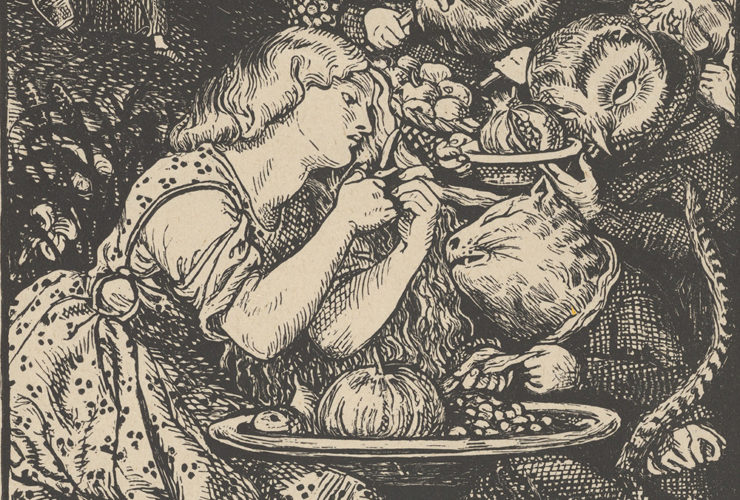Welcome back to Reading the Weird, in which we get girl cooties all over weird fiction, cosmic horror, and Lovecraftiana—from its historical roots through its most recent branches.
This week, we continue Max Gladstone’s Last Exit with Chapters 13-14. The novel was first published in 2022. Spoilers ahead!
Summary
“We ask the postapocalyptic crucifix randos very nicely to lend us a car?”
In the spring of her freshman year, Zelda first shows Sal the alts. They lie on the roof and gaze up into smoggy clouds. Sal looks at Zelda sidelong, humoring her. Sal is slipping away, because Zelda’s not worthy of her; she’s cool and strong, while Zelda’s scared; Sal “needs someone to walk beside her,” while Zelda needs her “to be one step ahead, and as big as the sky.”
Zelda “pressed her heart against the eggshell of the world, and willed, move, move.” And the clouds part, exposing stars and moons never seen above New Haven. Sal sees them, too. “What is this?” she asks. Later Zelda will chatter technicalities. For now she can’t speak.
Sal can see the alts now, but can’t step through. To “hitch” into alternate realities is most natural for Ramon, but Sarah and Ish can manage too. Zelda tries explaining the math, what “mental transformations” will gather spin. She tries traditional magical “props.” Sal remains “unhitched.” One night, as Zelda brainstorms solutions, Sal sits pointedly disinterested, internet-surfing. Why does Zelda need Sal to be an alt-rider? Maybe it just won’t work for her. Maybe she’s meant for the here-and-now world, where American soldiers are torturing prisoners in Abu Ghraib. She shows Zelda photos of their atrocities. Zelda’s sickened. “They’ll stop this,” she stammers. “They have to.”
From Sal’s look, Zelda knows that “if the world is a test, [she’s] just failed.”
Sal leads Zelda to the university administration building. Somehow Sal’s rigged her student ID for access to this house of mysteries. They go to an opulent conference room where the university board makes Decisions, overlooked by a painting of four men and a child. One of the periwigged fellows is the university “founder.” The child is black and has a collar locked around his neck. Everyone’s heard rumors of this painting, but the administration keeps it out of view. Sal accuses Zelda of wanting to escape this world’s ugly truths for extradimensional adventure. But, Sal says, “it doesn’t work that way.”
As Zelda weeps, heavy footsteps sound in the hall. Campus police? Wondering what they might do to Sal in particular, Zelda begins to understand “the edges” of what Sal’s trying to tell her. She’s already embraced a stiffly unresponsive Sal; now she pulls.
They land in a long-ruined conference room, under a sky vibrating to the cry of a great hunting cat. Sal’s embracing Zelda back, and laughing. Somewhere among the infinite alts, Zelda says, there must be one where they can fix things, make them right. “A crossroads,” Sal agrees, and now they have a shared goal.
* * *
After escaping from the cowboy, Zelda wakes on a cracked rooftop. The sky is cedar-red and bisected with a vast orbital ring. This alt was once highly advanced, but still fell. Rotting X-crosses with manacles stud the roof.
She is alone, for all that she clutched the others tight as they tumbled through alts. She fends off panic by telling herself they must be safe, just scattered, and that she will find them. Nevertheless, a “gnomelike” voice inside her whispers that she’ll never see her friends again, that all she does is fail.
Then someone groans: Ramon stirring under rubble. Zelda runs to him. They’re both aching, but have escaped serious injury. Ramon, though still “the half-honed, half-weakened product of the boy she had known,” doesn’t shout blame as her inner gnome expects. Instead he marvels at the orbital ring and tries to calculate how it was built. “What’s the plan?” he asks.
They’ll meet the others, as previously decided, at the Medicine Wheel. Once they’re on the road, Ramon can find them. First, though, they’ll need to find a car. His knack promises one down the ruined highway.
Zelda has to use her monocular to spot the vehicle. She also spots what could be campsmoke, but since the rooftop crucifixes look long-disused, she hopes the smoke-makers aren’t the ones who erected them.
Yeah, Ramon quips. They probably just killed and ate the crucifix guys.
That’s the spirit, Zelda tells him. Just like old times.
This Week’s Metrics
Against the Rot: Sometimes making the world a better place means retrieving long-lost knowledge from ancient, previously-unreadable tomes.
What’s Cyclopean: Dinosaurs are outlined against the sky, smelling of “rough feather-stink”. There seem to be a lot of dinosaurs in the alts, but if you think about the rarity of asteroid strikes, dinosaurs are the highest-probability denizens of Earth.
The Degenerate Dutch: Sal illustrates her impatience with alt-adventure by showing Zelda pictures of Abu Ghraib, and a portrait of Yale’s founder with an enslaved, collared African-American boy.
Weirdbuilding: For Zelda, the painting takes a moment to process: “It wasn’t instantly tritone abhorrent like some demon or Lovecraft monster, so that her mind refused to wrap around it.” Sal’s mind, on the other hand, has trouble with alt-travel. Zelda may want that skill to be pure math and science, but is willing to try and “help” Sal through yarrow and tarot, zodiac readings, and Hermetic chants. Maybe she should have tried green tea.
Ruthanna’s Commentary
If I had to guess who Zelda first taught to alt-jump, I would’ve assumed that she started with Sal. But no, she’s on the dinosaur road with Ramon first. Sal, who will ultimately run ahead of everyone, is the last to pick up “hitching.” She’s the last to think it’s important enough to do at all.
Zelda may want it to be math that breaks down the walls between worlds, but from here it looks suspiciously like desire doing the breaking.
Sal resists world-hopping not because she thinks it’s impossible, but because she thinks it’s a distraction from the real world. For Zelda, up to that point, it does seem to have been a boy’s adventure serial without larger purpose. It’s for Sal that she comes to the “conclusion” that alt-travel can save the world—as a way to keep her. Charitably, one might see the idea as a courtship gift. But it’s that larger meaning, the concept of the crossroads, that gives Sal the desire to jump. No wonder she’s the one who runs too far, too close. What did they think was going to happen, calling it a “crossroads” in the first place? Crossroads deals aren’t known for turning out well.
If I were a nervous sort, I might say the deal took place in that moment, when Zelda offers up the story of world-saving in exchange for Sal’s love. “She’s slipping away,” she says, before demanding exceptions to the impermanence of freshman flings—to her, precisely as impossible as magically changing this world to a better one. If one is possible, the other must be; world-saving must be possible in order to make their romance possible. This is Zelda-logic. To everyone else, she’s the larger-than-life hero. To her, Sal is the realest thing; she wants her not as an equal partner but “one step ahead, and as big as the sky.” And she gets—exactly what she says she wants.
The second-most-real thing to Zelda, once Sal shows it to her, is the painting hidden away in Yale’s administrative center: a portrait of the university founder with a boy he’s enslaved. It brings home her privilege, and differences between her and Sal other than the pedestal. She uses this epiphany to get them both away from campus cops who may or may not have guns, may or may not be extremely willing to use them against a woman of color. It’s literally weaponized ignorance, a trick I suspect you can only use so often.
The painting may be a power in its own right rather than just an image of power: Zelda imagines it thinking about the decision-makers who meet beneath it, enjoying its place where no one can approach who might make a fuss. “It wants us to know it’s here, and it wants us not to be able to do anything about it.” It’s notable that the white-hatted cowboy doesn’t appear in these chapters—except that the painting feels a lot like the cowboy? Certainly the ambiguously armed campus cops seem of a piece with that archetype: power unexamined, strong because unquestioned, hard to banish because rooted in original sins.
Pull all these threads together: If the crossroads is where you go to change this world into a better one, it must also be where you go to end the world, right? Remaking ends everything that came before, after all. Does Sal think she’s doing exactly what Zelda promised her, all those years ago—and that the cowboy is the destructive status quo?
Is she right?
And then we come out of memory to the present, and the gang’s first alt-travel together in years. But they’re no longer in a boy’s-own adventure, and no longer confident in even being able to find each other. Still, Zelda and Ramon can’t resist some of their habitual pluck, even as they flinch from now-equally-habitual fear and anger. At least there are—as always, apparently—pragmatic goals to distract them. Warlords to overthrow, princes to rescue… or in this case a car to retrieve from the postapocalyptic crucifix rando tow lot. Let’s hope the fine isn’t too steep.
Anne’s Commentary
Gladstone’s description of the Yale Corporation Room portrait spurred me to hunt for it online. As ever with the info-hoard that is the internet, it was a more complicated search than anticipated. Zelda doesn’t find the painting as “instantly tri-tone abhorrent” as a Lovecraft monster, or as “visceral” as the Abu Ghraib photos, but she’s shaken when she recognizes the depth of its banal-faced evil.
See it here for yourself. Four white guys in 18th-century finery and elaborate wigs, enjoying pipes and wine on the terrace above a garden where white children dance, well in the background as children should be, lest their noise disturb their elders. Zelda can be excused for not mentioning the frolicking kids. Her first impression is fair (and much like mine): Here’s another “indifferent piece of portraiture” like the ones Sal’s shown her in the Yale Center for British Art (YCBA). So “absolutely mediocre, absolutely normal.”
She can also be excused for not zooming in immediately on the figure to the far right. If not for his white pocket-flaps and cuffs and for the white band on his headgear, the black boy could fade into the shadow of his masters, as a good servant should. Once you see him, though, the apprehensive look he casts over his shoulder makes his face the most arresting of the five foreground figures. From noticing that look, your eye naturally catches the silver collar that marks him as a slave and his owner as a person of high status, rich enough to adorn even the throats of his minions.
Sal identifies the paunchy central figure as Yale’s founder, but she doesn’t dignify Elihu Yale with his name. Why should he get one while the black boy remains nameless? According to the Smithsonian Magazine article linked above, the YCBA team researching the boy has not yet discovered his identity. Assistant curator Edward Town hasn’t given up hope. Though some scholars believe that 18th century European artists painted black subjects not from life but according to stereotypes, Town finds this assumption “unsatisfying and wrong.”
Who in the picture owned this enslaved child? As a merchant who made his fortune in the East India Company, Elihu Yale would have profited from the slave trade, but it’s unclear whether he was directly involved in it. If a viewer were to infer that Yale owned the boy, well, that was probably the point. Many portraits of the period included enslaved people as “props” to give the principal subject an aura of wealth, empire, status. Mastery. As just one more emblem of the white man’s superiority, a proper complement to sumptuous fabric, marble columns and elegant landscaping, the possession of people becomes the kind of “monstrous normal thing” that Sal needs Zelda to face. Adventuring in the alts won’t let Zelda escape the realities of their own world, which include this: that the decision-makers of modern-day Yale University can gather under a celebration of subjugation. As long as the painting’s kept from the public eye, even if everyone on campus has heard of it, that’s fine. That’s optimal. Let them know it’s there, and that they can’t do anything about it.
In fact, the public did eventually (belatedly) do something. In 2007, after years of protest and controversy, the University removed Elihu Yale and His Servant from the Corporation Room. Here’s the twist. The painting Gladstone hangs in the over-mantel place of honor is not Elihu Yale and His Servant, but Elihu Yale With Members of His Family and an Enslaved Child, which hung at YCBA on and off since its donation to Yale in 1970. Here’s the actual Corporation Room portrait.
Arguably, Elihu and Servant is more offensive than Elihu and Family. It leaves no doubt about whom this silver-collared domestic belongs to. Yale towers (and bulks) over the dark-skinned man to an iconographic extent—he is Large and In Charge, while the servant is Shrunken in Subjugation and cartoonish in execution compared to his master. He looks like an afterthought, as if the artist smacked his forehead and cried “But wait, I forgot to include THE emblem of Yale’s supremacy!”
So why does Gladstone switch paintings? Also arguably, Elihu and Family is more offensive than Elihu and Servant in that its silver-collared domestic is not a down-sized adult but a child more or less in realistic proportion to the other figures, comparatively less stylized, more expressive, more sympathetic. He’s better suited to Sal’s mission, which is to remind Zelda that however infinite the alternatives may be, this world right here, with all its ugly history, is Sal’s and Zelda’s and inescapable.
And yet—when Zelda finally does manage to hitch Sal into an alt, Sal relaxes out of the pillar-like rigidity with which she’s been resisting Zelda’s embrace. She laughs, because the alt was not what she expected. Wrecked world as it is, she must see enough promise to be open to Zelda’s idea: an alt corresponding not to their worst nightmares but to their aspirational dreams.
It’s Sal who takes up Zelda’s idea and names that destination: a crossroads.
In the next chapter, jumping back to present story time, Zelda and Ramon land in an alt ruined like all the rest, but with a hint that positive change was made or at least attempted: The arc of a vast ring, an artificial habitat in stationary orbit around its planet. Was it—is it—a success? Or was it the last trigger of destruction? In any case, it’s a wonder.
In any case, Zelda and Ramon can still joke, just like in the old times, and that’s enough for them to go on.
Next week, we explore the (sinister?) motivations of gothic heroines in Mari Ness’s “The Girl and the House”.










